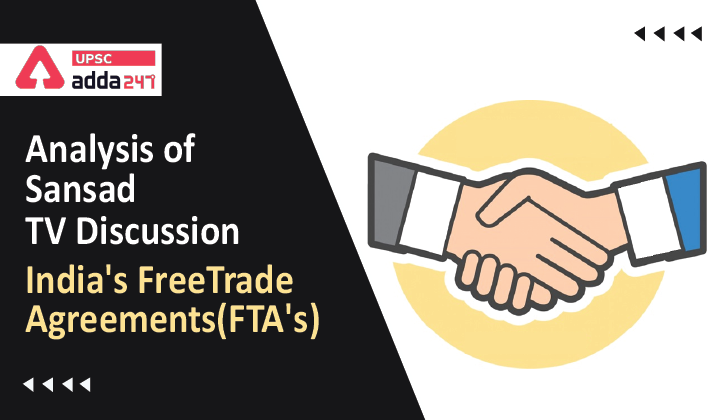Table of Contents
Introduction
- India and the United Arab Emirates (UAE) on February 18, 2022, signed a Free Trade Agreement (FTA), which is set to reduce tariffs for 80 per cent of goods and give zero duty access to 90 per cent of India’s exports to the UAE.
- The agreement, which is expected to come into effect in about 60 days, is expected to boost annual bilateral trade to $100 billion within 5 years of its adoption, up from about $60 billion currently.
- The agreement covers areas including goods, services, rules of origin, Customs procedures, government procurement, intellectual property rights, and e-commerce.
- Unlike with the UK and Australia, the trade deal with the EU — restarted after a gap of six years as the two sides earlier pulled out citing disagreements over tariff rules covering the auto sector and the free-movement rights for professionals — is a full-scale comprehensive FTA.
Why India Need FTAs
- Strategically, FTAs have helped India compete at a global level and enhance its growth.
- Last year Parliament Standing Committee on commerce in its report had recommended the government to iron out the issues hindering the signing of Free Trade Agreements with the US and the EU nations as domestic exporters are at a disadvantage due to the absence of these agreements.
What are Free Trade Agreements?
- Free trade agreements are arrangements between two or more countries or between a country and a trading bloc to abolish or reduce tariffs, quotas, and preferences on goods and services traded.
- Countries often agree to FTAs if their economic structures are complementary, not competitive.
- India currently has 11 Free Trade Agreements or Regional Trade Agreements with other countries/regions in addition to 6 limited coverage Preferential Trade Agreements.
What other Free Trade Agreements is India currently negotiating?
- India now has in place 11 FTAs and six PTAs (preferential trade agreements).
- In addition, India is negotiating 16 new and expanding seven existing agreements, including with trading partners such as Canada, the EU, the US, alongside Australia and the UK.
- India and Australia have recently announced that they are set to conclude an interim trade agreement in March and a Comprehensive Economic Cooperation Agreement (CECA) 12-18 months thereafter.
- A majority of FTAs under negotiations are “comprehensive” and cover goods, services, investment, IPR, etc.
- Non-Tariff Measures, regulatory procedures and trade facilitation are part of such negotiations.
- Meanwhile, India is also simultaneously carrying out a review of the existing FTAs with South Korea, Japan and ASEAN on the ground of India’s rising trade deficit with these trading partners. Experts noted that New Delhi may seek conditions in such FTA that trading partners import more from India.
What is the early harvest agreement?
- An interim or early harvest trade agreement is used to liberalise tariffs on the trade of certain goods between two countries or trading blocs before a comprehensive FTA (Free Trade Agreement) is concluded.
Key Benefits of Free Trade Agreements for India
- The Free Trade Agreements (FTAs) signed by India provide tariff concessions thereby giving opportunities for exports of products including those related to small and medium enterprises (SMEs).
- Intellectual Property Protection: protection and enforcement of India-owned intellectual property rights in the FTA partner country.
- Product Standards: Increases the ability for Indian exporters to participate in the development of product standards in the FTA partner country.
- Selling to the government: The ability of an Indian company to bid on certain government procurements in the FTA partner country.
- Service companies: The ability for Indian service suppliers to supply their services in the FTA partner country.
- Fair treatment for Indian investors providing they be treated as favourably as the FTA partner country treats its own investors and their investments or investors and investments from any third country.
Conclusion
It is a continuous endeavour to conclude the negotiations at the earliest. However, the deadline for completion of an FTA negotiation cannot be predicted as an agreement is reached only when all negotiating countries are satisfied with the outcome.



 TSPSC Group 1 Question Paper 2024, Downl...
TSPSC Group 1 Question Paper 2024, Downl...
 TSPSC Group 1 Answer key 2024 Out, Downl...
TSPSC Group 1 Answer key 2024 Out, Downl...
 UPSC Prelims 2024 Question Paper, Downlo...
UPSC Prelims 2024 Question Paper, Downlo...





